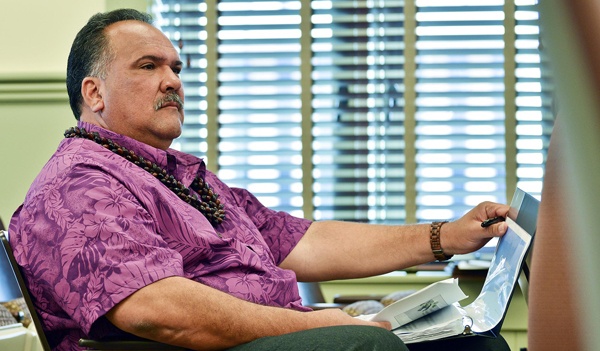LIHU‘E — Kaua‘i County Council Chair Jay Furfaro on Thursday may have summarized best the desire of the council to work alongside the administration while coming up with the county’s financial blue print for next fiscal year. During the next
LIHU‘E — Kaua‘i County Council Chair Jay Furfaro on Thursday may have summarized best the desire of the council to work alongside the administration while coming up with the county’s financial blue print for next fiscal year.
During the next few weeks, the council will meet daily with county department heads to massage Mayor Bernard Carvalho Jr.’s proposed budget for Fiscal Year 2014, which starts July 1. Furfaro said he wanted to describe the meetings as “ke ano wa‘a,” or the way of the canoe.
“We need to make sure that we follow the wa‘a to the point where … we’re in rhythm, that the canoe doesn’t jerk,” said Furfaro, adding the canoe should go “fast, timely, accurately and to the target.”
If Thursday was any indication of what’s coming, the council and the administration are willing to work together more than ever, but there may be several disagreements and no holding back on thoughts.
Carvalho said he would like to be on the same canoe with Furfaro, but because of their “husky size,” he would settle for paddling a canoe alongside the council.
“It’s my intent to work closely with you as we navigate these waters,” Carvalho said.
The administration took the council’s recommendation in delivering a tighter budget this year, after repeated years of ending a fiscal year with tens of millions of dollars in general fund balance, or surplus.
Carvalho said the administration started working on this budget back in August. After meetings with department heads, consulting with council members and receiving public priority surveys, Carvalho asked in January for each department to take a new approach, called “2012 plus 10.”
By using actual expenditures for Fiscal Year 2012 as a baseline (FY 2013 actuals will be released later this year), the administration added 10 percent to account for increased costs, and asked each department to target those parameters.
The result were cuts between $95,000 and $1.8 million, according to Carvalho. Altogether, the budget reduction was $7.8 million.
The reduction in operational costs, however, is not sufficient to balance the budget.
“It’s going to be a difficult budget, in what is a difficult year,” Furfaro said.
Finance Director Steven Hunt said the administration has relied in general fund balances to balance the budget in the last few years, but in today’s picture, this option is not available. This year’s budget won’t make anyone happy, he said, but will provide for adequate maintenance and keeping essential services.
The administration is increasing many fees and real property taxes, which has drawn much criticism from council members Gary Hooser, Mel Rapozo and Ross Kagawa. On the day before the opening of the budget reviews, all three voted against a proposal to increase fuel taxes.
Furfaro said the council is also to blame for increased expenditures, because it voted to increase several services that the community had wanted. Also, charter amendments approved by voters created additional millions of dollars in startup and upkeep costs.
Hooser criticized the administration for mis-management that took to the county to a difficult financial decision, though he concurred with Furfaro that part of the responsibility laid with the council — a council that Hooser was not part of.
Despite criticizing fee increases, Kagawa said the council was largely to blame for the financial situation rather than the council, because it is the council that ultimately approves the budget.
Rapozo said he repeatedly told the administration the last two years where the county would be if they didn’t cut — and was the only council member voting against the final budget in 2011 and 2012.
Councilman Tim Bynum said Carvalho has been doing an “outstanding” job in budgeting; his criticism was with the administration’s — and the council’s — revenue management, as tax rates were kept the same as real property values kept dropping in the last few years.
The result were tens of millions of dollars that were not collected mainly from property owners who don’t live here, while resident homeowners, who had been protected by a tax cap in the early 2000s, saw their taxes increase after 2008, when the real estate values started dropping, according to Bynum.
Councilwoman JoAnn Yukimura praised the administration for proposing a fuel tax increase to support the Kaua‘i Bus, but also lashed at the county’s speed and focus in recycling opportunities, which she wants to be more aggressive.
At the end of the day, council members said they wouldn’t be rehashing criticism throughout the budget review process. Rather they said they wanted to move forward and work with the administration.
“We have a game to play, and it’s a big game,” Kagawa said.
The council and the administration will meet daily to review the budget until April 16, with the exception of Wednesdays, when the council holds its weekly meeting. From May 9 to 14, the council will work on Carvalho’s supplemental budget submittal.
Visit www.kauai.gov to download the complete schedule for the budget review sessions.
• Léo Azambuja, staff writer, can be reached at 245-0452 or lazambuja@ thegardenisland.com.


